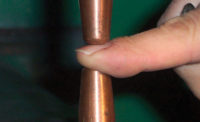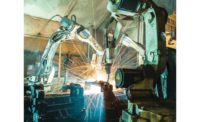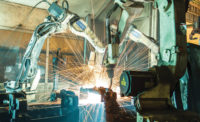Unlike conventional machinery, robots lack the intelligence of a human operator. In the event of a programming error or hardware malfunction robots have the potential to unexpectedly move large distances at a high rate of speed, posing a serious danger to operators or maintenance personnel.
Accident statistics maintained by OSHA identify 27 fatalities associated with robots in a 30-year period from 1984 to 2013. This doesn’t mean safety in industrial automation should be taken lightly; like any machine, robots can be dangerous when they are deployed improperly or used carelessly.
This can make the selection of appropriate safeguarding methods more difficult than for conventional automation in which the operating envelope, motions and other performance parameters are defined.
Deadly risks
Here are seven potential risks OSHA identifies with robotics:
- Human Errors: OSHA lists prior programming, interfacing activated peripheral equipment, or connecting live input-output sensors to the microprocessor or a peripheral as human errors that can lead to dangerous, unpredicted movement or action by the robot. OSHA stresses that operators may place themselves in hazardous positions due to over familiarity or lack of knowledge of the robot’s motion path.
- Control Errors: If the controls system faults, the system response may lead to a dangerous working environment if it is closely coupled with human interaction.
- Unauthorized Access: An unauthorized operator can find himself or herself in a dangerous and potentially fatal area where they are unfamiliar with the safety hardware.
- Mechanical Failures: During the design and programming stages, mechanical part failure is not always taken into account. Failure can lead to a potentially hazardous situation.
- Environmental Sources: Unsuppressed power surges or power loss can lead to injury if they are not planned for during the initial stages of the project.
- Power Systems: Pneumatic, hydraulic, or electrical power sources that have malfunctioning control or transmission elements in the robot power system can disrupt electrical signals to the control and/or power-supply lines. This can produce a hazardous release of energy.
- Improper Installation: If the robotic work cell is incorrectly set up, hazards may occur due to variance from the original design.
Safeguarding techniques
Fencing — the primary means of safeguarding — closes off the area around the robot and firmly establishes a set perimeter. Curtains may be installed on the fence to keep debris from being thrown outside the perimeter or to protect employees from arc glare. Recently, soft axis and space limiting have given integrators more control of fencing requirements. Smaller cell footprints still maintain the 20 inches required around the workspace. Standards also allow for the use of movable guards with switches interlocked with the power supply to turn power off whenever the guard door is open. When guard door movement is detected, the interlock switch sends a stop signal to the guarded robot.
Light curtains, laser scanners, and pressure sensitive mats are other commonly used means to control access to the robotic work cell. Light curtains emit harmless infrared light beams across the entrance. When a beam is blocked, the light curtain control circuit sends a stop signal to the guarded machine. Laser scanners continuously rotate and emit an optical signal to detect the intrusion of objects within an area. If the scanner detects an intrusion into the pre-defined zone, it sends a stop signal to the guarded machine. Pressure sensitive safety mats guard the entrance to the cell. An operator’s footstep will cause the mat control unit to send a stop signal to the robot.
Safeguarding standards
OSHA doesn't have a specific standard on industrial robots. OSHA's general view on robot safety is that if the employer is meeting the requirements of ANSI/RIA R15.06, Industrial Robots and Robot Systems-Safety Requirements, then the manufacturer has no issues.
ANSI/RIA R15.06 are consensus standards written by the Robotics Industry Association (RIA) to provide guidance on the proper use of the safety features embedded into robots, as well as how to safely integrate robots into factories and work areas. The latest revision of the standard, ANSI/RIA R15.06-2012, references for the first time ISO 10218-1 & 2 to make it compliant with international standards already in place in Europe. Part 1 of ISO 10218 details the robot itself; Part 2 addresses the responsibilities of the integrator.
There are also new requirements in ANSI/RIA R15.06-2013 for collaborative robot systems or “cobots,” where the robot system and operator share the same workspace at the same time, without safety fencing. A different set of safety standards has been established for cobots, in this case, ISO 10218 and the ISO/TS 15066 Technical Specification. This standard clarifies the four types of collaboration: Safety Monitored Stop, Hand Guiding, Speed & Separation Monitoring and Power & Force Limiting.
The requirement for risk assessments is one of the biggest changes in the new RIA standard. The integrator, or the end-user if they are performing the job of an integrator, now must conduct a risk assessment of each robotic system and summarize ways to mitigate against these risks. This may involve procedures and training, incorporating required machine safeguarding, and basic safety management. Risk assessments calculate the potential severity of an injury, the operator’s exposure to the hazard, and the difficulty in avoiding the hazard to arrive at a specific risk level ranging from negligible to very high.
Risk assessments have always been a best safety practice via ANSI B11.0. It is important to note no OSHA regulation specifies that risk assessments are required. ANSI and RIA 15.06 are “appropriate” standards referenced by OSHA (see OSHA 1910.212). OSHA can only cite a customer for not conducting a Robot Risk Assessment via OSHA 1910.212 and referencing the ANSI B11.0 and RIA 15.06. There is not an OSHA regulatory requirement to do so.



